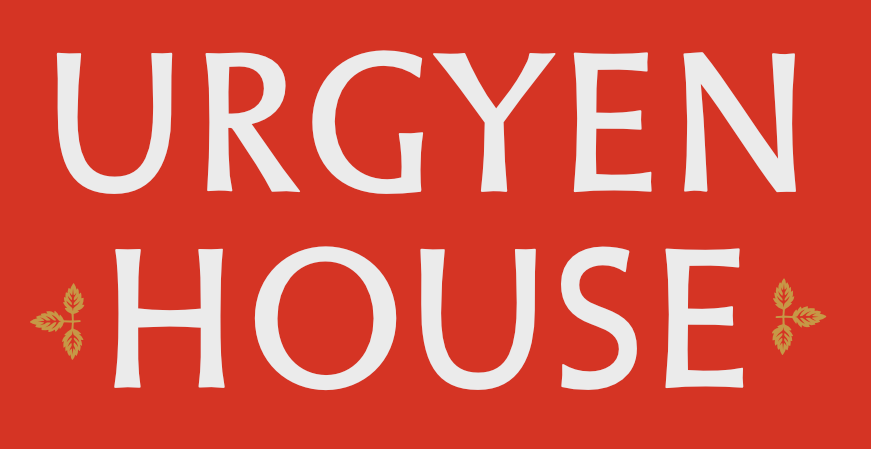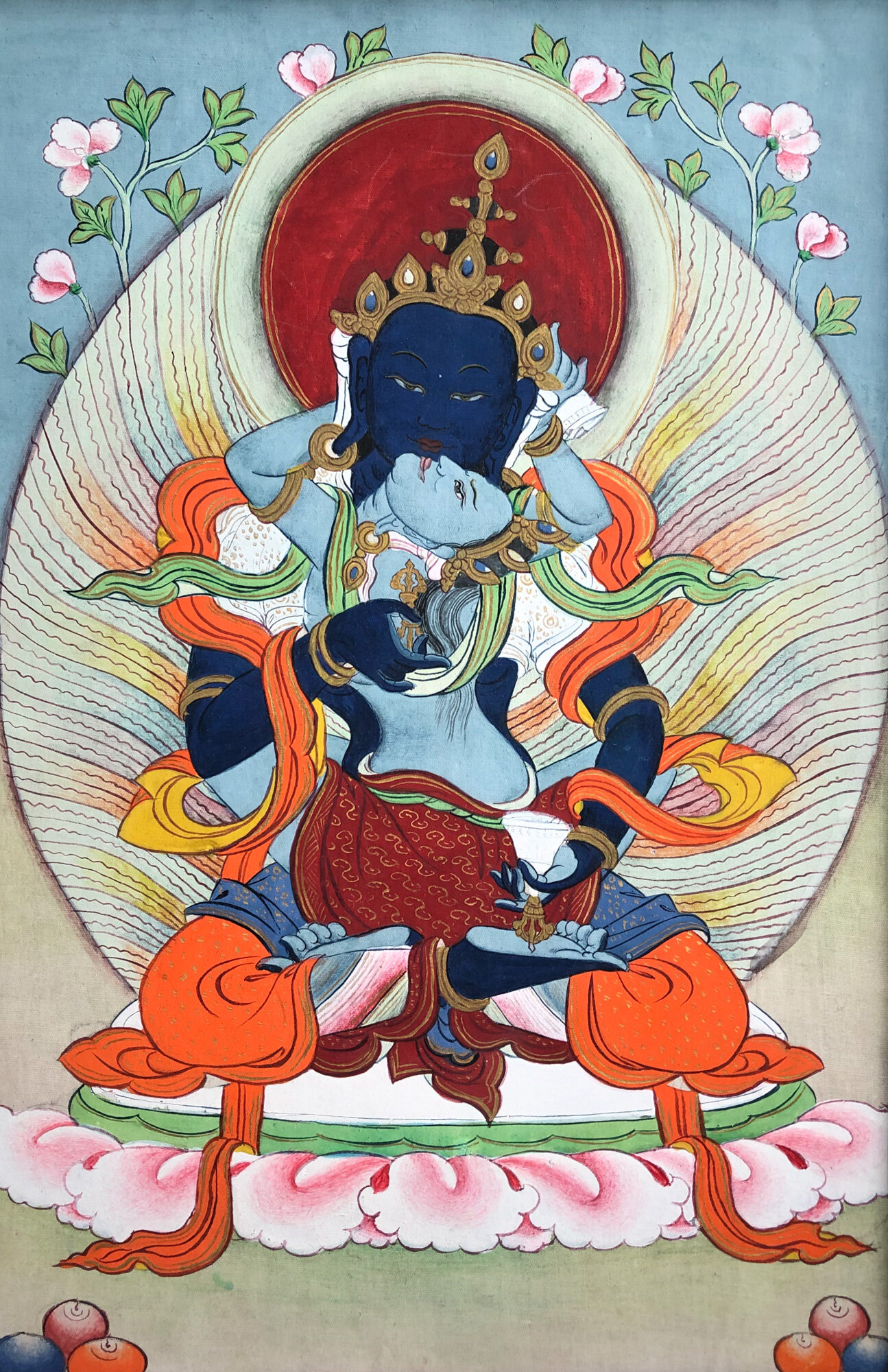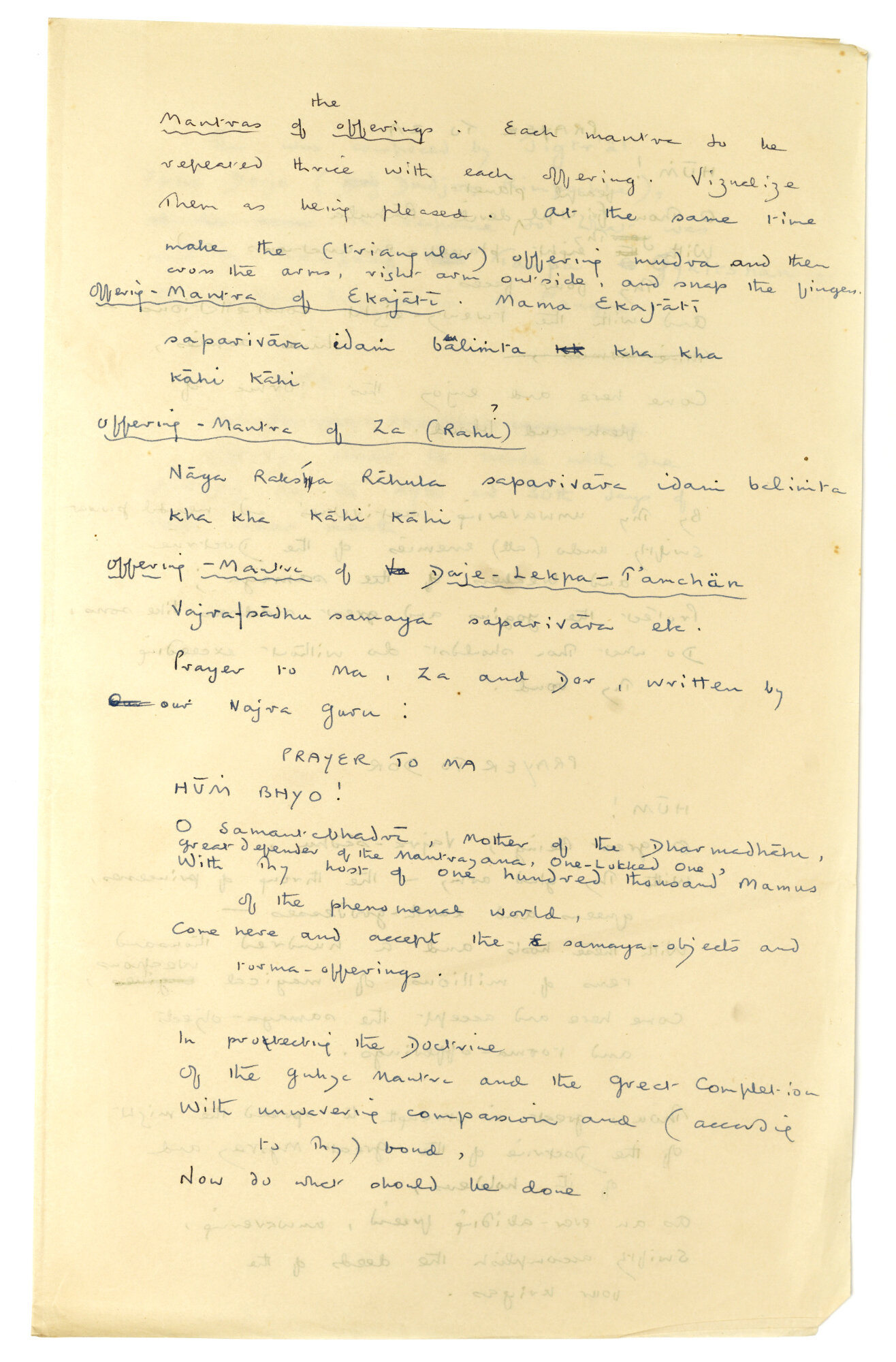Dudjom Jigdral Yeshe Dorje (1904–1987) was a master of the Nyingma tradition. He wrote the definitive Nyingma School of Tibetan Buddhism: Its Fundamentals and History. During the early 1960s, to protect Tibetan Buddhist teachings and Tibetan culture, he was appointed as the first overall head of the Nyingma lineage. Sangharakshita was introduced by Dudjom Rinpoche to the Mahāyoga of the Anuttaratantra through a Vajrasattva initiation into the text and sādhana of The Essence of Profound Meaning: Being the One-Mudra Sadhana of Him Who Annihilates Hell. Later, Rinpoche condensed the sādhana for Sangharakshita in a text called Order of Preliminaries to the Confounder of Narak.
“He stood absolutely still, and I had the distinct impression that it was not just his bodily stillness. His mind, also, was absolutely still, as though the various winds that usually agitate the surface of our consciousness had in his case ceased to blow and he was at peace, in the deepest sense of the phrase, with himself and with the world.”
Precious Teachers in The Complete Works of Sangharakshita, vol. 22, p.501
Blue Vajrasattva (The Hell-Annihilator) and Consort
“When I received the Vajrasattva abhiṣeka from Dudjom Rimpoche there was … a point at which I definitely felt something pass from him to me, but it was not something that could be described in terms of power…. I also commissioned small paintings of the Hell-Annihilator and the three guardian deities from an old Tibetan artist, a refugee whom Dudjom Rimpoche had recommended to me.”
Precious Teachers in The Complete Works of Sangharakshita, vol.22, pp.502–3
This is the small painting of Vajrasattva that Sangharakshita commissioned. Writing about the sādhana, Sangharakshita explained that Vajrasattva annihilates hell “for those who have broken their vows and Tantric commitments by purifying them of the deep-seated mental defilements” and that he is “associated with purification in the deepest and most radical sense of the term.”
Precious Teachers in The Complete Works of Sangharakshita, vol.22, p.504
Ekajaṭī, Rāhu, and Vajrasādhu text
“At the end of the third day…Dudjom Rimpoche bestowed on us the fourfold abhiṣeka of Ekajati, Rāhu, and Vajrasādhu, the principal guardian deities of the Nyingma tradition, explained how offerings were to be made to them, and gave us a copy of offering-prayers of his own composition. His work, in a sense, was finished; but ours had just begun.”
Precious Teachers in The Complete Works of Sangharakshita, vol.22, p.506
Once Sangharakshita had his final translation, he typed out these verses of supplication and offering to the three Nyingma Protectors on parchment paper. They lay on the shrine in his bedroom for many years.
Ekajaṭī, Rāhu, and Vajrasādhu text notes
Dudjom Rinpoche gave Sangharakshita verses he had composed for supplication and offering to the three figures sworn to uphold and protect the teachings of the Nyingma Tantras and Revealed Treasures. These are some of Sangharakshita’s notes while he worked on transposing them to English verse.
Ekajaṭī, Rāhu, and Vajrasādhu thangka
Sangharakshita commissioned this thangka from a painter that Dudjom Rinpoche had recommended to him. It is in the classic Tibetan style known as nagtang: mainly gold lines on a black background. It shows the three wrathful protectors of the teachings of the Nyingma school of Tibetan Buddhism: the fierce goddess Ekajaṭī, protector of the Secret Mantra Tradition, is in the centre. With one braid of hair flying upwards, one eye, one fang and one breast, she represents ultimate unity. Rāhu is shown with his primary face on his belly. The nine heads represent the heavenly spheres – the moon, planets and so on – which he has swallowed, displaying their forms on his own body. He seems to represent bringing into control and harmony all the worldly forces needed to support the Dharma. Dorje Legpa, a servant of Vajrapāṇi, here rides on the back of a snow-lion and carries out the wishes of his Bodhisattva master to protect all the revealed treasures (termas) of the Dharma.
Dudjom Rinpoche’s account of lineage of the sādhana, with signature
This document was given by Dudjom Rinpoche to Sangharakshita and is an account of the transmission lineage of empowerments and teachings from which the ‘Confounder of Hell’ sadhana derives. Rinpoche appends his own name in his own handwriting at the bottom.
The lineage of the transmissions and empowerments of the Vajrasattva Peaceful and Wrathful Deities Dredging the Depths of Hell is as follows: Samantabhadra, Vajrapani, Kukuraja, Indrabhuti, Shakyaputri, Singharaja, Uparaja, Gomadevi, Humkara, Buddhaguhya, Vimalamitra, Nyaklo Shonnu, Sogpo Lhapal, Nubchen Sangye Yeshe, Su Lekpey Dronma, Sey Shonnu Nyingpo, Zhuton Khorlo, Zurchen Shakya Jungney, Zurchung Sherab Drakpa, Lan Pawo, Gartön, Setön Dorje Gyaltsen, Lan Dorje Ӧ, Lan Sonam Gyaltsen, Lan Chökyi Senge, Lan Chökyi Senge, Lan Sangye Pal, Sonam Gönpo, Samdrup Dorje, Sangye Rinchen, Gölo Shönnu Pal, Sonam Gyatso, Setön Chenpo, Gyahor Dorje, Panchen Pema Wangyal, Rigdzin Gyi Tön, Zurchen Chumikpa, Terdak Lingpa, Khenchen Chöpal, Rinchen Namgyal, Pema Tendzin, Trinley Namgyal, Trinley Chödrön, Sangye Kunga, Tenzin Norbu, and Pendey Ӧzer, who passed this to me.
Jigdral Yeshe Dorje
(Translated: Heidi Nevin 2021)








